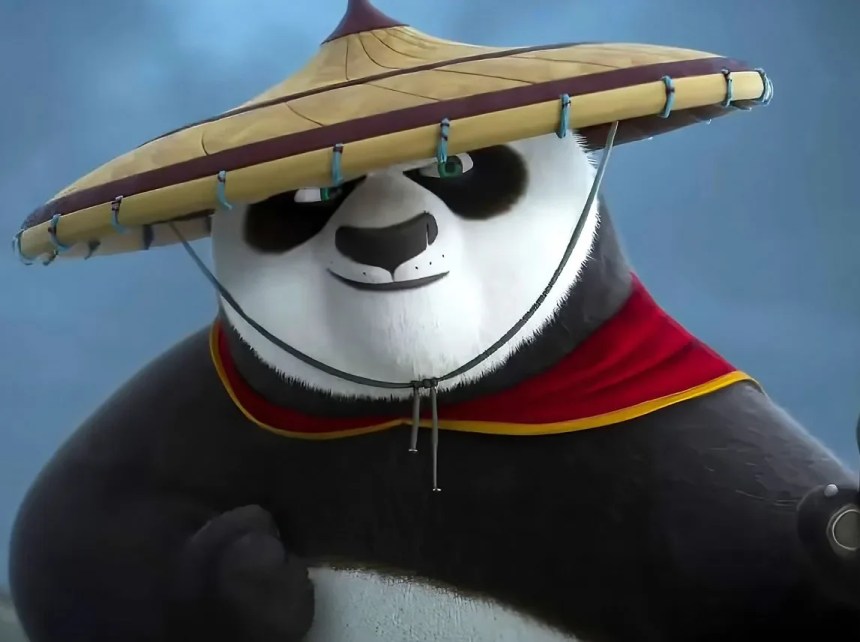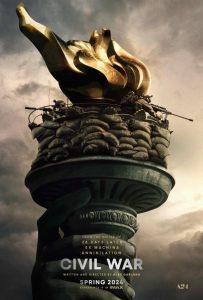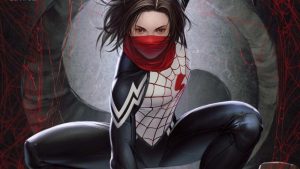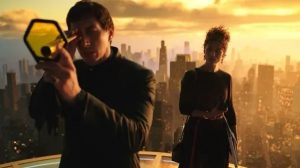
FUN AND ENJOYABLE,
BUT NOT A “SKADOOSH” SEQUEL
Back in 2008, DreamWorks Animation released their newest animated feature Kung Fu Panda, a tale that’s mixed martial karate, Chinese ascetic mythos, and hilarious cartoon frivolities. Directed by John Stevenson and Mark Osborne, the film, which starred the voice talents of Jack Black, Dustin Hoffman, Ian McShane, James Hong, and Angelina Jolie, is set in an ancient China realm that’s populated by anthropomorphic animals, and follows the journey of a bumbling, tubby panda named Po, who dreams of learning kung fu marital arts, gets his chance to do so as he is named to the “Dragon Warrior”, a prophesized hero worthy who is destined to save the land from the villainous and savage snow leopard Tai Lung from the Valley of Peace. The movie, which was well received from critics and moviegoers, went on to gross over $630 million at box-office, became the highest grossing animated movie that year, and even garnished nominations for “Best Animated Feature” in both the Golden Globes and the Academy Awards. As if by a forgone conclusion, a sequel movie was inevitable and in 2011 Kung Fu Panda 2 was released. Surprisingly, the movie lived up to its predecessor (a feat that’s rare for a sequel to do) and further continued the karate-chop hijinks adventure of series character Po and his martial art companions as the kung fu fighting panda learns of “inner peace”, while battling against the deadly and cold-hearted peacock, Lord Shen. With better animation and solid voice talents (both new and old to the franchise), Kung Fu Panda 2 roughly grossed the same amount at the box office and receiving similar praise from viewers. In 2016, Kung Fu Panda 3 was released and gave viewers another solid animated adventure for Po and his friends to explore, finding the tale of Po discovering his long-lost father to be compelling, while battling against the ruthless General Kai’s spiritual energy might to be entertaining. Like before, the third sequel offered a lot of the main staples as the previous films (great animation, style, and voicework) and gained critical and financial praise from viewers and the box office, effectively “closing out” the main narrative in a trilogy style fashion. Now, eight years since the release of the last film DreamWorks Animation Studios (under the Universal Studios banner) and director Mike Mitchell gear up to reopen the world of animal kung fu martial arts fun with the release of Kung Fu Panda 4. Does this fourth installment capture the same magic as the previous chapters were able to achieve or has the time come to retire this franchise once and for all?
THE STORY
Years have passed since Po (Jack Black) ascended to the title of Dragon Warrior, with the oafish Panda still maintain a likeable authority in the Valley of Peace by using his kung fu skills to defend the land while his partners, the Furious Five, are away on separate mission in other realms. However, Master Shifu (Dustin Hoffman), believes the time has come for Po to assume the title of Spiritual Leader, and name a successor to the Dragon Warrior title, which the tubby panda is having a difficult time with such a decision, unwillingly to relinquish the role that he love been. Such a verdict is shattered when word reaches them that being known to all as The Chameleon (Viola Davis), a dangerous reptilian shape-shifting sorceress interested in opening the Spirit Realm and collecting the power of all dangerous bad guys within. Rising to the challenge, Po heads to Juniper City to confront The Chameleon, joined by newcomer Zhen (Awkwafina), a sly and fast-talker thief who’s interested in taking down the villain. Hot on their trail are Ping (James Hong) and Li Shen (Bryan Cranston), with Po’s fathers determined to protect their son from all potential peril that awaits him. Yet, despite what lies in store in Juniper City, Po must overcome one of the difficult facts of growth…. change.
THE GOOD / THE BAD
As many of you know by now…. I’ve always been a big fan of animated movies. Not just for the colorful animation, relatively short runtime, or even the customary recognizable voice talents that are usually attached to the project, but for how engaging it can be for its audiences, with some proving that animated motion pictures are not just for children. Such is the case of the Kung Fu Panda series. Within the DreamWorks catalogue library of their releases, this series is definitely in the top tier of their animated feature films, which stands right alongside the Shrek and How to Train Your Dragon franchise. It’s true that the saga of Po’s journey to become the legendary Dragon Warrior is one of “zero-to-hero” plot cliché, but what transpired throughout that journey (through the movies) is quite compelling, hilarious, and just a lot of entertainment value. If I had to pick my favorite one…..it’s a tossup between the first and second one. The first film has a great balance of its characters and action, while introducing us (the viewers) to the film’s setting and major plot. Definitely a good start to a franchise as well as just a good stand-alone movie altogether. Kung Fu Panda 2 definitely utilized the first film the correct way, using it springboard off of and creates and very engaging, enlightening, and just an all-the-way-around fun and terrific sequel, which boasted plenty of humor and heart throughout the movie. It was definitely one of the rare times that a sequel lived up to its hype. Plus, I did love Gary Oldman as the voice of Lord Shen as the main antagonist. That’s not to say that Kung Fu Panda 3 was bad as it was really good and somewhat concluded Po’s journey to become the Dragon Warrior arc, but I did feel the first two movies were just a little bit better…. in terms of storytelling and character balance. Overall, I felt that the Kung Fu Panda movies are some of the best work from DreamWorks Animation Studios, providing plenty of fun and entertainment to a story that finds plenty of time for heart and action in a tale of tubby panda’s to master the ways of kung fu panda and saving the day from evildoers.
This brings me back to talking about Kung Fu Panda 4, a 2023 adventure-comedy animated production from DreamWorks Animation and the fourth installment in the Kung Fu Panda series. As mentioned, the ending of Kung Fu Panda 3 basically closed out the main storyline of the franchise and thus I felt that the series (much like How to Train Your Dragon saga) concluded on a high note and really didn’t need to be extended beyond that. Basically, not to ruin a really good thing with subpar sequels like so many other franchise tag film series have done before. So, I was kind of surprise to hear that DreamWorks announced that a fourth chapter in the Kung Fu Panda series was greenlit and was going to be released in 2024. As one can imagine, I did have my immediate doubts about this notion, especially since (as stated) the story somewhat closed the narrative out with the previous film. So why reopen the tale of Po again? After that initial announcement, I really didn’t hear much about the project until the film’s movie trailer began to appear both online and in theater (during the “coming attractions” preview reel), with the preview showcasing the continuation of Po’s journey with a new ally companion and a new adversary to defeat. It definitely looked (visually speaking) great and the voice talents attached to the project were enticing (i.e. Black, Hoffman, Awkwafina, and Davis), but I was still leery about the film, especially since I was fearful of how reopening the franchise would damage it. Still, I was looking forward to seeing it and did get the chance to watch it during its opening day theatrical release on March 8th, 2024. However, due to my work schedule and trying to complete some of my other reviews, I did have to push my getting my review done for this animated flick. Now, with some free time on my hands, I’m finally ready to share my personal thoughts on this particular cartoon sequel. And what did I think of it? Well, it’s a mixture of both good and bad for me. Kung Fu Panda 4 is indeed a fun return to Po’s on-going story of kicking butt and protecting the innocent, but the reopening of such a martial arts tale isn’t as “awesome” as expected, with the project acting as the weakest entry in the franchise. Don’t get me wrong….the film is still enjoyable and entertaining, but seems subpar to what has come before, which is tad disappointing.
Kung Fu Panda 4 is directed by Mike Mitchell, whose previous directorial works include several other DreamWorks Animated film such as Shrek Forever After, Trolls, and The LEGO Movie 2: The Second Part. Thus, given his familiarity of working with various DreamWorks projects in the past, Mitchell does seem like a suitable choice to helm the fourth installment of this particular series, one that is held in high regard within the studio’s vault. To his credit, Mitchell does do a decently good job in capturing the spirit and familiarity that is very much “in-line” with the previous films; making this fourth chapter in Po’s journey to feel like a proper continuation. There is some questionable motives as to why a sequel was to be made (more on that below), but Mitchell does what he can with the feature and does cultivate in a film that has all the right piece in mind for animated presentation that feels fun, humorous, and cinematically dramatic. Like the previous entries, Mitchell does make the movie feel quite breezy within its runtime and, while just themes and messages are displayed in full force, the film never gets weighed down with unnecessary moments and details.
While the Kung Fu Panda movies have always been a balanced of comedy and heart, the splurge of action scenes are definitely some of the highlights of these movies, with Mitchell matching the intense excitement and actions thrills from the previous installments and engaging viewers in a fast and rock-an-roll stunts of cartoon kung fu mastery. In Kung Fu Panda 4, Mitchell stages several fun and unique action setups sequences that definitely highlight some of the best (and most fluid) style of animation from this franchise. Coupled with the beautiful art style of animation (more on that below), Mitchell has a keen eye for a strong attention to detail in depicting the various fights of martial arts in a very sleek manner. Thus, dynamic fight scenes bringing loads of fun and attention to detail in these movement throughout the picture, which almost leads to an anime level of style / quality in every punch, flip, twist, and combo-like finishers throughout the proceedings. So, regardless if the movie isn’t the best that the series has to offer, there is no denying the fact that Kung Fu Panda 4 has some of the best action scenes that the franchise has to offer.
Looking beyond the stylistic animation, humorous bits, and martial arts action, one of the most interesting aspects that the Kung Fu Panda movies have to offer are the thematic moral lessons to be learned. Perhaps the biggest one is mentioning “change” and how it can affect a person. Change is a particular thing, especially since he can disrupt a person’s overall life flow, fearing letting go to who / what an individual was, and accepting something new on the horizon. Such fundamentals of change are quite palpable and the main crux of the movie’s story and themes. Po doesn’t want to give up his title as Dragon Warrior and is fearful of letting that go and becoming something else, which is totally relatable because we (as human beings) have felt that way in some shape or form in our lives. Heck, this theme is projected on the main villain, with the Chameleon able to change forms at a whim and still feels loathing towards others. Her and Po’s journey (as well as Zhen) are reflections of how people perceive change and how they are confronted by it, which, for a kids movie, is pretty good. Heck, this sort of reminded me a little bit of the morals and themes found in Cars 3, which I did praise for having a good story in its lessons to be learned. Thus, Kung Fu Panda 4 goes to show its viewers that just because it’s a kids movie doesn’t mean the fundamental ideas can be extrapolated from this animated medium
In its presentation, Kung Fu Panda 4 is beautifully rendered animated feature film that certainly, by today’s standards, looks absolutely the best of what cartoon movies have to offer. In truth, the series (visually speaking) has always looked fantastic, imagining a very lively world of colorful characters (heroes, villains, and those in-between) in a fantasy-like realm that bleeds into Asian culture style, motifs, and nuances. That does not just extends to background settings and location, but to also the fluid movement that all the characters flow through as well as personality facial features / expression. It’s all quite striking and gorgeous to look at, with this fourth installment showcasing the best and brightest of what a DreamWorks’s animated film has to offer….visually speaking. Thus, the film’s “behind the scenes” main players such as Paul Duncan (production design) as well as the entire art direction department and the animation artist should be praised for their efforts in bringing this pseudo Chinese fantasy world to life with incredible flair and visual compelling ways. Plus, as before with the previous films, the movie boasts plenty of cinematic moments and scenes that are truly breathtaking to see, especially for an animated film. Thus, the cinematography work for Kung Fu Panda is amazing across the board and, with the heightened and intricate details that the feature’s animation is displaying, truly does capture some great cinematic sequences that could rival any live-action movie. Lastly, the film’s score, which was composed by Hans Zimmer, is another solid illustration from the famed composer by delivering and beautiful musical composition that invokes plenty of cinematic quality feeling through the usage of melodies, sweeps, and bombastic animated fun and action. All in all, great job throughout the entire feature presentation.
Unfortunately, Kung Fu Panda 4 isn’t quite as awesome as the previous entries were, with the animated film drawing criticism throughout its undertaking and overall execution. How so? Well, for starters, the movie itself is a bit unnecessary……sad but true. As stated above, the conclusion of Kung Fu Panda 3 perfectly closed out the narrative of Po, who finally ascend to the role of Dragon Warrior; completing the character arc that was started with the first movie. Kung Fu Panda 4, however, reopens the franchise with a new adventure that, while compelling and understandable to a certain degree, sort of feels like a superfluous and almost written / presented in a manner of fanfiction to the story of Po. While there is nothing wrong with fanfiction writing, the movie’s story feels a bit half-baked and isn’t exactly fleshed out in the correct way. Certain parts are repetitive and similar to the rest of the franchise, with such rehashing of a formulaic nature proving to be problematic. In truth, the movie is in desperate need of some more substance within its plotting and narrative. Sure, the theme of change and some of the new characters are a welcome addition, but it feels like there could’ve been more to it all. More time for certain characters, especially the ones who are missing from the film (more on that below), more time for storytelling beats, and more time for the ending, which does seem a tad too rushed.
As a whole, the direction of Kung Fu Panda 4 is a bit too familiar and really doesn’t try too hard to break the successful formula that the previous entries were able to cultivate. Yes, these movies (collectively) are better handled / represented than the average animated features out there (i.e. a cut above the rest), but this fourth entry definitely shows that the franchise is starting to show its wear and tear, losing the momentum in further continuing such exploits of animal kung fu warriors. Thus, the movie is somewhat a safe bet for the younger viewers out there, but doesn’t really color outside the lines too much; resulting in an animated feature does seem at times to be on autopilot for lengthy sequences. That’s not to say what’s presented is enjoyable and humorous or even touching, but Mitchell’s direction for the movie doesn’t really challenge the status quo of the Kung Fu Panda franchise and ends up being a very run-of-the-mill installment. Of course, Mitchell does hit all the right notes when molding and ultimately shaping the film the right way, but it is a tune that’s been played out before in the past Kung Fu Panda endeavors and would’ve been better received if there was a bit more creative ingenuity placed on the project…..in a similar way that Puss in Boots: The Last Wish was to its 2011 counterpart.
Lastly, the movie does feel like it is “cutting corners” in a few key areas by omitting certain franchise characters from the movie and / or not incorporating several previous voice talents in characters that are to be seeing and not heard. Well, the biggest “black mark” on this is the absence of the Furious Five (i.e. Tigris, Mantis, Monkey, Crane, and Viper) and how the movie sort of dismisses these characters from the main plot. While these five characters are, more or less, side / supporting roles in the grand scheme of things in the Kung Fu Panda franchise, their absence in this sequel is felt. Yes, one can argue that their removal from the narrative gives more time and focus to several new characters and reinforces several old ones (for a new medium storytelling), but the Furious Five have always been a part of the Kung Fu Panda franchise brand, with their inclusion being both humorous and memorable throughout their participation in the main narrative. The same can be said with two other “missed opportunities” of characters who briefly return in the movie, but are not afforded any dialogue lines. Of course, a reason for this probably that the filmmakers couldn’t get the acting talent due to schedule reasons, but, in the end, it does feel like the movie is lacking the vocal performances from characters that could’ve (and perhaps should’ve) been in the film. Again, this might be a personal criticism rather than general one, but it was quite a bit of a disappointment to see (or hear) some of these characters in this movie.
Speaking of voice work, the cast of Kung Fu Panda is (of course) top-notch across the board with every single acting talent involve on this particular sequel project up to the task of bring these animated characters to life with plenty of colorful energy dynamic vocal range to make them memorable throughout. Of course, leading the charge in this category is without a doubt actor Jack Black, who returns to reprise his protagonist character role of Po. Black, who is known for his roles in School of Rock, Jumanji: Welcome to the Jungle, and The Super Mario Bros. Movie, has always been a great comedic actor, utilizing his talents in the correct way that makes for amusing and (most times) hilarious moments throughout the many characters he has portrayed over the years. Po is one such character, with Black hitting all the right notes and tones with this loveable panda with heaps of humor and heart throughout the course of his many adventures. Thus, it’s quite a delightful treat to see Black reprising Po once again and bring the same type of zany, goofy voicework to the new film, which makes him even more endearing and lovable as before. I’ll never get bored of hearing Black voicing Po. As a character, Po’s journey arc is actually compelling to see unfold, though (again) still a bit unnecessary. He’s older and made a bit wiser, but doesn’t want to let go of his title as Dragon Warrior, afraid of what he might become after and letting go what he likes to do. It’s great and fundamental works for the movie, but there is just a slight retread in character growth / plot pointing in Po’s journey, which does breed that formulaic and predictable notion. It would’ve been nice to see something a little bit different in his character growth for the classic “passing the torch” to the next generation cliché / trope, but, as a whole, Po is still a loveable and fun character to root for and Black’s hilarious engaging voice work continues to be endearing and memorable.
Looking beyond the title character, the movie finds a new sidekick companion for Po in the form of Zhen, a corsac fox who is a master thief, quick with her witty banter, and follows Po on his journey to find The Chameleon, and who is voiced by actress Awkwafina. Known for her roles in Crazy Rich Asians, The Farewell, and Shang Chi and the Legend of the Ten Rings, Awkwafina has certainly made a name for herself in Hollywood over the past decade, appearing more and more frequently in more prominent projects in both lead and large supporting characters. Given her very distinct sounding voice, Awkwafina does seem like the perfect choice to be a part of this animated film series, with her work on this installment is actually pretty good. Her vocal performance as Zhen is solid across the board and I do like how they (the animators) made Zhen have a normal looking animalistic face rather than something utterly zany and exaggerated by trying to capture Awkwafina’s expressiveness. Awkwafina does bring the right amount of sarcasm and heart to the character, which is a perfect foil for Black’s Po as the pair bounce off their “back and forth” banter in a humorous way. The character herself is interesting because it feeds directly into the main plot of “change” and how Po slowly becomes a somewhat mentor to the young thief. In the end, I know that some people out there don’t particular care for Awkwafina (some find her annoying in her various performances), but I think she was a great fit for the character of Zhen and a great addition to the cast of the Kung Fu Panda movies.
As for the antagonist of the movie, the character of The Chameleon, a cunning and shape-shifting chameleon sorceress and who is voiced by actress Viola Davis, is sort of mixed bag in my opinion, yet still relatively a good bad guy for Po to tackle in this narrative plot. As mentioned, the character design for this particular baddie is superb and is filled with incredible detail. Thus, the character is quite visually stunning….even for a villain for Po to face off against. Plus, fitting into the main narrative theme of “change”, a bad guy that is an actual chameleon that changes forms is quite appealing and worthy adversary to face off against. In addition, Davis, who is known for her roles in The Help, Fences, and The Woman King, is devilishly wicked in the movie and can easily tell she is having a great time voicing such a character; something that the previous voice work for the Kung Fu Panda villains were able to achieve. The problem, however, is that the character herself does seem to be lacking in the narrative scheme of the feature’s plot. Yes, The Chameleon is bad and wants to conquer the world, but that’s pretty much it and with a somewhat weak backstory to fuel her vengeance. So, while Davis is perfectly cast for the role, The Chameleon, when comparing to McShane’s Tai Lung, Oldman’s Lord Shen, and Simmon’s General Kai, does seem a bit on the limp side and perhaps the weakest / least favorite of the baddies in this series.
Additionally, speaking about bad guys, it was great to hear actor Ian McShane (Deadwood and John Wick: Chapter 4) reprise his Kung Fu Panda villain role of Tai Lung, a martial arts expert snow leopard who Po defeated in the first film. McShane has a very distinct sounding voice and how he delivers his dialogue lines (in any project) is spot on, so to hear him again (as Tai Lung) was definitely a treat and delight in the movie.
Who also returns in the movie (from the previous films) are Po’s two dads….Mr. Ping, a Chinese Goose and Po’s adoptive father, and Li Shen, a panda and Po’s biological father, who are voiced by actors James Hong (Big Trouble in Little China and Everything Everywhere all at Once) and Bryan Cranston (Breaking Bad and Malcolm in the Middle) respectfully. Both characters have proven to be solid side characters in the Kung Fu Panda storyline, showcasing the parental figures within Po’s upbringing, with both Hong and Cranston bringing the right amount of fatherly sounding voice, wisdom, and bickering banter to make their sum parts. The movie does provide the two dads for having their own little side adventure as they trail after Po in worry, which does offer a fun distraction in breaking away from Po / Zhen’s journey towards the Chameleon, but it also does feel a bit unnecessary at times and could’ve been easily removed from the film and still retain the same fundamental conclusion. Still, it was great to have Hong and Cranston return. Likewise, actor Dustin Hoffman (Rain Man and Kramer vs. Kramer) reprise his character role of Master Shifu, a wise red panda and Po’s master, and continues to be quite humorous in his dry / gravitas dialogue lines that he exchanges with Black’s Po throughout the movie. Unfortunately, much like the second and third entries, Shifu’s role in the main plot is limited and basically bookends the feature. Still, despite that, it was great to hear Hoffman again as Master Shifu.
Rounding out the rest of the cast, includes actor Ke Huy Quan (Everything Everywhere all at Once and Indiana Jones and the Temple of Doom) as a Sunda pangolin who is leader of a den of thieves in Juniper City named Han, actor Ronny Chieng (Crazy Rich Asians and Joy Ride) as a green arowana fish appropriately named Captain Fish, actress Lori Tan Chinn (Orange is the New Black and Awkwafina Is Nora from Queens) as an elderly female boar named Granny Bear, actor Harry Shum Jr. (Glee and Everything Everywhere all at Once) as a fire-breathing crocodile named Scott, are delegated to minor supporting characters in the movie. Though while are all limited screen time, most of these characters are welcomed additions in the film’s story and are well-voiced by the talents that play them.
FINAL THOUGHTS
After serving as the Dragon Warrior for several years, Po must come to terms on ascending to his next important role in life, while teaming up with trickster thief and thwart the plans of the nefarious Chameleon in the movie Kung Fu Panda 4. Director Mike Mitchell’s latest film returns to the popular martial arts franchise for a whole new adventure, showcasing the importance of change that must happen on Po’s personal life journey as well as dealing with new ally and a new threat. While the movie is indeed with weakest entry in the series and gets bogged down with rushed parts, a formulaic narrative, and lacking substance / characters, it does make up for it with fantastic animation, a beautiful score, great cinematography, exciting kung fu staged action, and some great voice acting across the board. Personally, I felt that this movie was good, but not quite as good as the past three installments in the franchise. There is plenty to like about this movie, it good message to learn, and it’s still a fun and entertaining animated romp of the feature to view, but it is perhaps the most unnecessary one, especially since the last entry somewhat closed out the story of Po, and (by that factor alone) makes this movie the weakest entry. Still, while it may not shine the brightest, it’s still a good cartoon movie to watch for pure animated enjoyment. Thus, my recommendation for this movie would probably be a “recommended” one, especially for fans of the Kung Fu Panda series, but then maybe also a “rent it” for everyone else. Again, it’s definitely better than a lot of other animated movies of late, but just a stepped down from what had come before from the previous film chapters, which makes the project not really a “must see” in theaters and could easily be passed over for a streaming family movie night later down the road. The conclusion of the movie leaves the door open for a possible further sequels, with Kung Fu Panda possible acting as the start of a new trilogy in the series. That being said, I’m not quite sure if one is needed. Yes, it would be fun to see another one, but only if there is something worth telling instead of exhausting the franchise and running it in the ground like so many have done before. In the end, however, Kung Fu Panda 4, despite showing wear in the franchise is starting to lose its momentum, is still a colorful and fun animated romp that is enjoyable in its animated antics and kung fu martial arts frivolity.
3.7 Out of 5 (Recommendation / Rent It)
Released On: March 8th, 2024
Reviewed On: May 2nd, 2024
Kung Fu Panda 4 is 94 minutes long and is rated PG for martial arts action / mild violence, scary images, and some mild rude humor
The post Kung Fu Panda 4 (2024) Review appeared first on Jason’s Movie Blog.







